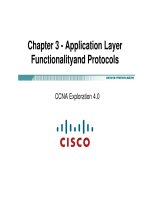Tài liệu Chapter 2 - Communicating over the Network CCNA Exploration 4.0 docx
Bạn đang xem bản rút gọn của tài liệu. Xem và tải ngay bản đầy đủ của tài liệu tại đây (1.58 MB, 54 trang )
Chapter 2 - Communicating
over the Network
CCNA Exploration 4.0CCNA Exploration 4.0
Overview
• Describe the structure of a network, including the devices
and media that are necessary for successful
communications.
• Explain the function of protocols in network
communications.
• Explain the advantages of using a layered model to
Học viện mạng Bách khoa - Website: www.bkacad.com
• Explain the advantages of using a layered model to
describe network functionality.
• Describe the role of each layer in two recognized network
models: The TCP/IP model and the OSI model.
• Describe the importance of addressing and naming
schemes in network communications.
Introduction
• In this course, we focus on these aspects of the information network:
– Devices that make up the network.
– Media that connect the devices.
– Messages that are carried across the network.
– Rules and processes that govern network communications.
– Tools and commands for constructing and maintaining networks.
Học viện mạng Bách khoa - Website: www.bkacad.com
The Elements of Communication
• Communication begins with a message, or information, that must be sent from
one individual or device to another.
• People exchange ideas using many different communication methods. All of
these methods have three elements in common:
• Message source
• The channel
• Message destination
Học viện mạng Bách khoa - Website: www.bkacad.com
Communicating the Messages
• A better approach is to divide the data into smaller, more manageable pieces
to send over the network. This division of the data stream into smaller pieces is
called segmentation.
• Segmenting messages has two primary benefits:
– First, by sending smaller individual pieces from source to destination, many
different conversations can be interleaved on the network.
– Second, segmentation can increase the reliability of network
communications.
Học viện mạng Bách khoa - Website: www.bkacad.com
communications.
Communicating the Messages
• The downside to using segmentation and multiplexing to transmit messages
across a network is the level of complexity that is added to the process.
• In network communications, each segment of the message must go through a
similar process to ensure that it gets to the correct destination and can be
reassembled into the content of the original message.
Học viện mạng Bách khoa - Website: www.bkacad.com
Components of the Network
• Network Components:
– Hardware: Devices and media.
– Software: Services and processes.
Học viện mạng Bách khoa - Website: www.bkacad.com
Components of the Network
• Devices
Học viện mạng Bách khoa - Website: www.bkacad.com
Components of the Network
• Media
Học viện mạng Bách khoa - Website: www.bkacad.com
Components of the Network
• Services and processes
Học viện mạng Bách khoa - Website: www.bkacad.com
End Devices and their Role on the Network
• The network devices that people are most familiar with are called end devices.
These devices form the interface between the human network and the
underlying communication network. Some examples of end devices are:
– Computers (work stations, laptops, file servers, web servers)
– Network printers
– VoIP phones
– Security cameras
– Mobile handheld devices (such as wireless barcode scanners, PDAs)
Học viện mạng Bách khoa - Website: www.bkacad.com
– Mobile handheld devices (such as wireless barcode scanners, PDAs)
Intermediary Devices and their Role on the Network
• Intermediary devices to provide connectivity and to work behind the scenes to
ensure that data flows across the network.
• These devices connect the individual hosts to the network and can connect
multiple individual networks to form an internetwork. Examples of intermediary
network devices are:
– Network Access Devices (Hubs, switches, and wireless access points).
– Internetworking Devices (routers).
– Communication Servers and Modems.
Học viện mạng Bách khoa - Website: www.bkacad.com
– Communication Servers and Modems.
– Security Devices (firewalls).
Intermediary Devices and their Role on the Network
• Processes running on the intermediary network devices perform these
functions:
– Regenerate and retransmit data signals.
– Maintain information about what pathways exist through the network and
internetwork.
– Notify other devices of errors and communication failures.
– Direct data along alternate pathways when there is a link failure.
– Classify and direct messages according to QoS priorities.
– Permit or deny the flow of data, based on security settings .
Học viện mạng Bách khoa - Website: www.bkacad.com
– Permit or deny the flow of data, based on security settings .
Networking Media
• Communication across a network is carried on a medium. The medium provides
the channel over which the message travels from source to destination.
• These media are:
– Metallic wires within cables
– Glass or plastic fibers (fiber optic cable)
– Wireless transmission
Học viện mạng Bách khoa - Website: www.bkacad.com
Networking Media
• Different types of network media have different features and benefits.
• Criteria for choosing a network media are:
– The distance the media can successfully carry a signal.
Học viện mạng Bách khoa - Website: www.bkacad.com
– The environment in which the media is to be installed.
– The amount of data and the speed at which it must be
transmitted.
– The cost of the media and installation.
Local Area Networks
• Networks infrastructures can vary greatly in terms of:
– The size of the area covered.
– The number of users connected.
– The number and types of services available.
• Local Area Network (LAN): An individual network usually spans a single
geographical area, providing services and applications to people within a
common organizational structure, such as a single business, campus or region.
Học viện mạng Bách khoa - Website: www.bkacad.com
Wide Area Networks
• LANs separated by geographic distance are connected by a network
known as a Wide Area Network (WAN).
• WANs use specifically designed network devices to make the
interconnections between LANs.
Học viện mạng Bách khoa - Website: www.bkacad.com
The Internet – A Network of Networks
• Although there are benefits to using a LAN or WAN, most of us need to
communicate with a resource on another network, outside of our local
organization.
• Examples of this type of communication include:
– Sending an e-mail to a friend in another country
– Accessing news or products on a website
– Getting files from a neighbor's computer
Học viện mạng Bách khoa - Website: www.bkacad.com
– Getting files from a neighbor's computer
– Instant messaging with a relative in another city
– Following a favorite sporting team's performance on a cell phone
The Internet – A Network of Networks
• A global mesh of interconnected networks (internetworks) meets these human
communication needs.
• The Internet is created by the interconnection of networks belonging to Internet
Service Providers (ISPs).
• Intranet is often used to refer to a private connection of LANs and WANs that
belongs to an organization, and is designed to be accessible only by the
organization's members, employees, or others with authorization.
Học viện mạng Bách khoa - Website: www.bkacad.com
Network Representations
Important terms to remember are:
• Network Interface Card(NIC).
• Physical Port .
• Interface.
Học viện mạng Bách khoa - Website: www.bkacad.com
Rules that Govern Communications
• A protocol stack shows how the individual protocols within the suite are
implemented on the host. The protocols are viewed as a layered hierarchy,
with each higher level services depending on the functionality defined by the
protocols shown in the lower levels.
Học viện mạng Bách khoa - Website: www.bkacad.com
Network Protocols
• At the human level, some communication rules are formal and others are
simply understood, or implicit, based on custom and practice. For devices to
successfully communicate, a network protocol suite must describe precise
requirements and interactions.
• Networking protocols suites describe processes such as:
– The format or structure of the message.
– The process by which networking devices share information about.
pathways with other networks.
Học viện mạng Bách khoa - Website: www.bkacad.com
pathways with other networks.
– How and when error and system messages are passed between devices.
– The setup and termination of data transfer sessions.
Network Protocols
• The format or structure of the message
Học viện mạng Bách khoa - Website: www.bkacad.com
Network Protocols
• The process by which networking devices share information about
pathways with other networks
Học viện mạng Bách khoa - Website: www.bkacad.com
Network Protocols
• How and when error and system messages are passed between devices
Học viện mạng Bách khoa - Website: www.bkacad.com









